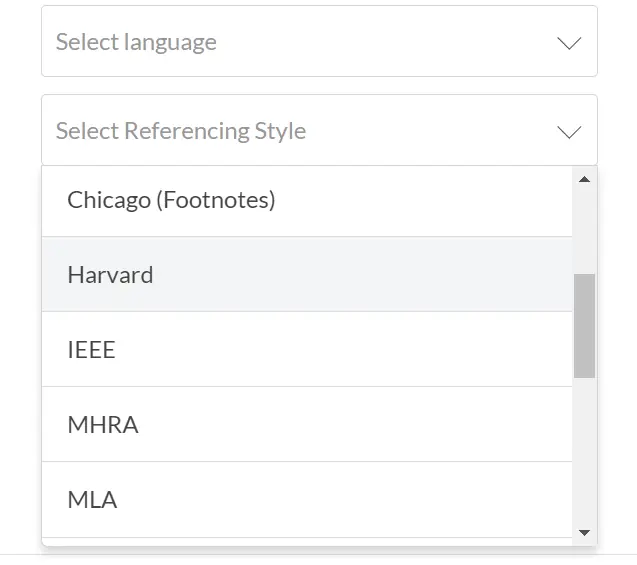Introducing AMA Referencing
The AMA Manual of Style: A Guide for Authors and Editors was developed by the American Medical Association for use in their own publications, but it is now used by medical publishers and academics around the world. And if you’ve been asked to use ‘AMA referencing’, you’ll need the citation style set out in this guide.
This system is set out in the 11th edition of the AMA Manual of Style. But if you don’t have access to the full volume, our guide here should explain the basics.
AMA Proofreading Services
Our proofreading experts have in-depth knowledge of AMA referencing. So if you have a document that uses AMA citations or other elements of AMA style, you can trust us to check it for errors.
How To Select
AMA Referencing
When you upload an academic document to our system, we’ll ask you to select a referencing style. So if you’re using AMA, just pick ‘AMA’ from this list.
And if you have further instructions for your editor (e.g. a specific edition of AMA you would prefer us to use), just add them here in the comment box.

Instant Quote
In-Text Citations In AMA Referencing
AMA is a number–endnote system (also known as ‘Vancouver’ style). This means:
- You cite sources with numbers in the text, usually at the end of a sentence
- Citation numbers point to entries in a reference list at
- Sources are numbered in the order you first cite them
AMA referencing does this with superscript numbers, like this:
Shea and Wilson’s research shows treatment rates have improved since 1975.¹
Here, for instance, the superscript ‘1’ shows that we’re citing the first source in the reference list. To cite the same source again, we’d simply use the same number. The main variations on this citation style include:
- Adding a page number in brackets after a citation number
- Citing multiple sources in one place (with either a hyphen for consecutive sources or an unspaced comma between numbers for non-consecutive sources)
You can see examples of both of these below:
According to Weishaupt, the technique ‘originated in Bavaria in 1776.’2(p34) However, several studies have cast doubt on this origin, claiming it to be inconsistent with various medical accounts of the period.1,3-5
For instance, the ‘2’ at the end of the first sentence above is a citation for page 34 of the second source in the reference list. The citation at the end of the passage, meanwhile, is for the first, third, fourth, and fifth sources in the reference list.
Creating AMA Reference Lists
As mentioned above, in AMA referencing, you list every source you cite in a ‘reference list’ at the end of the document. This is where you provide publication information for cited sources, allowing your readers to find the texts you’ve used in your research. The rules for creating an AMA reference list include:
- List all sources in the order they are first cited in the document
- List authors surname first, followed by an initial with no full stop
- For sources with more than six authors, include the names of the first three followed by the Latin term ‘et al.’
- Do not list any source more than once
- Italicise titles of books, journals, government bulletins, and pamphlets; do not italicise titles of other sources
- Capitalise the first letter of each major word in a book, journal, government bulletin, and pamphlet titles; for other sources, capitalise only the first letter of the first word, proper names, and abbreviations that are ordinarily capitalised
- Use the NLM’s abbreviated titles for journals
- Cite unpublished sources (e.g. letters or emails) parenthetically in the text and do not add them to the reference list
The exact reference format for each source will depend on the source type. You can see example references for a book, a website, and a print journal article below:
Print Book
Shea R, Wilson RA. Medical Organizations: The Past and Present. New York, NY: Dell Publishing, 2008.
Website
Dorn G, Goodman S. The Origins of Meditation as Medical Treatment. Medical History Archive. http:/www.medicalarchives.org.edu/articles/2004/
medidation-medical-treatment-04062008.html. Published 4 June 2008. Accessed 27 August 2019.
Print Journal Article
Malik J. A Longitudinal Study of Ongoing Treatment for Patients Receiving Physical Therapy. Phys Ther Res. 2010;90(1):6-10.
You can find out more about AMA reference formats in the AMA Manual of Style.
Referencing Styles And Systems
Our expert editors can work with a range of referencing styles, including:
We can work with other referencing styles on request, too. Just let us know which system you’re using when you upload your work, and we’ll tailor our service accordingly. For more information on legal referencing styles, such as OSCOLA and AGLC, see our dedicated legal referencing page.




